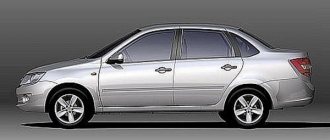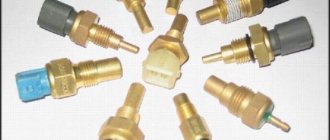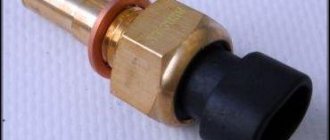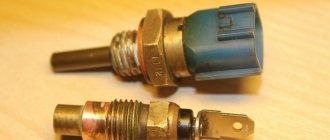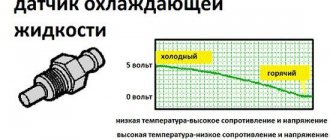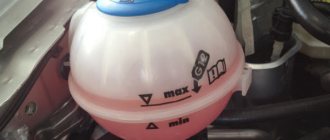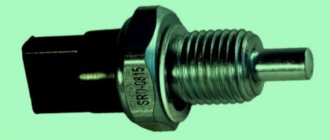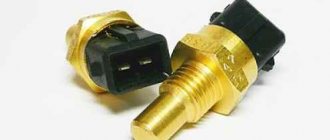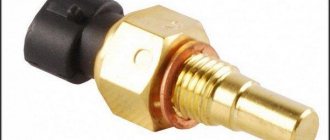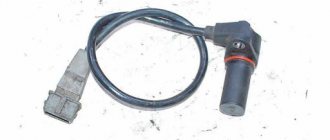We remove the sensor for replacement if irregularities are detected in the readings of the coolant temperature indicator in the instrument cluster. On a car with an F16D3 engine...
...the coolant temperature indicator sensor is screwed into the cylinder head in its lower part under the intake pipe of the first cylinder, next to the coolant temperature sensor of the control system (the intake pipe has been removed for clarity).
To remove it, drain the liquid from the cooling system.
Disconnect the wire from the temperature gauge sensor.
Using a 13mm head, unscrew the temperature gauge sensor...
...and remove it.
On a car with an A15SMS engine.
...the coolant temperature gauge sensor is located at the top of the engine - screwed into the threaded hole in the intake manifold.
Therefore, when replacing it, you can do without completely draining the coolant.
Drain a small amount of coolant through the radiator cap.
By sliding, disconnect the wire tip from the sensor.
Using a high head “12” we turn out the sensor...
...and remove it .
Install the sensor in reverse order. The thread of the sensor is conical, so we screw the sensor until the rotation resistance increases significantly, after which we slightly “tighten” the sensor. We pour coolant into the cooling system and bring its level to normal (see “Replacing the coolant”). ( 8
Source: https://daewoo.biz/remont-daewoo/nexia-2008/remont-avtomobilya/sistema-okhlazhdeniya/snyatie-datchika-ukazatelya-temperatury-okhlazhday/
Where is the Gentra temperature sensor: location, replacement
Often, when the cooling system fan on a Daewoo Gentra does not work, it is necessary to check the temperature sensor. In this case, it is necessary to know the location of the node in order to carry out diagnostics and replacement.
Sensor location
Sensor diagnostics
There are a number of factors that indicate a malfunction of the temperature sensor. Let's consider what causes and diagnostic methods exist:
If the coolant temperature sensor is not working, you need to check the fuses first.
- If the temperature gauge shows excessively high or low temperatures, warm up the engine.
- If the temperature sensor shows a high temperature when the engine is not yet warmed up, disconnect the wires from the sensor. If temperature changes are observed, then the sensor should be replaced. If the sensor shows a high temperature, then the wires are shorted.
- If after warming up the engine the temperature sensor is still not functioning and the fuses have been checked, turn off the engine. Disconnect the wire from the sensor and ground it to the engine body. Turn on the ignition without starting the engine. If the sensor shows high temperature, it should be replaced.
Replacement
When the engine is completely cool, remove the radiator cap, compress the upper radiator hose and replace the cap.
- Disconnect the sensor from electricity.
- Prepare a new temperature sensor.
- Install a new sensor.
- Carefully insert the sensor and connect the wiring harness.
Add coolant and start the engine. Check the system for leaks.
Conclusion
The Daewoo Gentra coolant temperature sensor is located on the cylinder block. You can diagnose the unit yourself; to do this, you only need to remove the part from the car.
Source: https://koreanautoreview.com/daewoo/gentra/gde-naxoditsya-datchik-temperatury-dzhentra.html
Recommendations for care and maintenance of sensors
- Strictly follow the manufacturer's recommendations regarding vehicle maintenance schedules;
- Buy parts with original catalog numbers. The exact data is indicated in the instruction manual for your technical device;
- Carry out preventive maintenance, install consumables and spare parts in certified service stations. Relevant while the car is under factory warranty. There are frequent cases of warranty cancellation due to third-party intervention.
- When the first signs of engine malfunction appear, contact a service station;
- Do not install sensors from other car brands, even though they are compatible. External similarity does not guarantee full functionality in action;
- Carefully check the catalog numbers on the parts when purchasing and compare them with the markings indicated in the operating instructions.
If you encounter any difficulties with replacement, please contact service station specialists or car dealership managers for help. Additionally, read reviews from car enthusiasts on the Internet.
Temperature sensor on Daewoo Nexia: where is the DTOZH located?
There are many different sensors in cars that provide information to the driver about speed, temperature, oil, pressure and much more. Regardless of the make of the car and the type of engine - 8 cl or 16, without a well-coordinated control system it is impossible to function properly.
It is no secret that the level of heating of a car engine directly affects its performance, and therefore the functioning of the entire vehicle system as a whole.
Two points help regulate the temperature level of the motor:
- ventilation system;
- coolant.
The quality of operation of the cooling system is monitored by sensors located in its area.
Daewoo Nexia has three detectors monitoring the heating state.
The coolant temperature sensor is designed to monitor the heat level of the coolant, allowing the system to determine the required richness level of the fuel mixture, as well as determine the need to activate the fans.
For models of different generations of Daewoo Nexia, the coolant temperature sensor is located in different places:
- for N150 - it is fixed near the ignition coils;
- on N100, under the ignition distributor;
- for cars running on F16D3 engines, the detector is located between the second and third cylinders.
Checking the DVT on a Daewoo Nexia is as easy as on any other simplest car - using a multimeter and a thermometer.
The detector is dismantled, connected to the device, switched to ohmmeter mode, and then lowered along with the thermometers into a container with heated coolant.
The obtained degrees and Ohms are compared with a table, on the basis of which conclusions are drawn about the performance of the device.
The second temperature device is a coolant temperature gauge analyzer. On the Daewoo Nexia, a temperature sensor of this type is located in the cylinder head (near the first of them), not far from the intake manifold. The serviceability of the device is checked in the same way as the DTOZH.
The third device that regulates engine operation is the intake air temperature detector. The sensor is located in the air filter housing of older Daewoo models, or in the air pipe of newer cars. This sensor is checked in the same way as the previous two.
The peculiarity of these devices is that if one of them fails, most likely there will be a need to check all three in turn, since the signs of their malfunction are generally the same:
- difficulty starting the car;
- excessive consumption of fuel;
- Unstable operation at idle.
What is a Rustle security sensor?
How to replace DTOZH on Daewoo Matiz?
The principle of replacing the device does not differ from the similar procedure for other models of this manufacturer, be it Daewoo Espero, Nexia, 8-valve or 16 cells. there is no fundamental difference. It is necessary to follow several general rules and know exactly where the device is located for this particular model:
№Useful information
| 1 | first, you need to turn off the engine and cool it completely |
| 2 | remove parts under the hood if they interfere with free access to the detector |
| 3 | drain the coolant into a prepared container |
- disconnect the wires from the device;
- unscrew the sensor;
- replace it with a new one;
- perform all the above manipulations in reverse order;
- Start the engine and check the functionality of the system.
Source: https://alertok.ru/oborudovanie/datchiki/gde-nahoditsya-datchik-temperatury-v-deu-neksiya.html
Location
The Daewoo Nexia vehicle has several types of engines, and therefore the sensors are installed in different places:
- N150. DTOZH is located near the ignition module.
- N100. You can find the DTOZH under the distributor.
- F16D3. The gauges are located between cylinders 2 and 3.
All sensors on Daewoo Nexia
The coolant temperature sensor receives the temperature of the coolant and sends data to the ECU to form the fuel-air mixture. The sensor signals regulate the fuel-air mixture, so if the sensor malfunctions, increased fuel consumption and difficulty starting the engine are possible, especially in winter. The Check Engine light comes on on the dashboard.
Location: Located under the ignition coils (Euro-3) and under the ignition distributor (Euro-2). On the F16D3 engine, it is located under the intake manifold between the first and second cylinders of the engine.
Coolant Temperature Gauge Sensor
The coolant temperature gauge sensor on the Nexia is used to display the antifreeze temperature on the dashboard. You can find out the exact readings of the sensor by connecting a diagnostic scanner to the ECU.
Location: The sensor is located under the intake manifold, in the area of the first cylinder.
On some models, it is possible that the DTOZH and DTOZH are the same sensor.
Crankshaft position sensor (CPS)
The crankshaft position sensor on the Nexia determines the speed and position of the crankshaft. If the sensor fails, the engine will not be able to start or operate.
Location: The sensor is located at the crankshaft pulley opposite the toothed disk. on the F16D3 engine the sensor is located under the oil filter.
Camshaft position sensor (CPRV, phase sensor)
The DPRV sends a signal to the ECU about the position of the camshaft and the opening of the injectors for more efficient execution of the stroke.
Location: The camshaft position sensor on the F16D3 engine is located near the timing case at the top of the engine.
Throttle Position Sensor (TPS)
The throttle position sensor on the Nexia sends a signal to the ECU about the throttle position, controlling the air supply. Signs of a malfunction of the DZ position sensor - the Nexia will not respond to the gas pedal, the speed will randomly increase and jump regardless of your efforts to press the gas.
Air flow sensor
The mass air flow sensor is necessary to account for the air entering the engine. These parameters are necessary for the correct composition of the fuel-air mixture before it enters the combustion chamber. Inside the sensor there is a special sensitive element that counts the air passed through it and transmits the readings to the computer.
Signs of malfunction:
- Increased fuel consumption;
- Idle speed fluctuates;
- The engine stalls spontaneously;
Daewoo Nexia 2008. The smell of antifreeze in the cabin
Daewoo Nexia 2008. The smell of antifreeze in the cabin
Leak from expansion tank
As a rule, the cabin smells of coolant if it leaks from the expansion tank. In most cases, this malfunction is caused by long-term operation of the vehicle or a violation of the technical condition of the car.
But, no matter how surprising it may be, antifreeze leaks often occur on modern cars. The main reason for antifreeze leakage is wear of system components or manufacturing defects. Also, working fluid may leak if pipes or other components of the cooling system are incorrectly replaced.
Since the coolant tends to erode, the car owner may not notice a slight leak of the mixture. In this case, a malfunction of the car’s cooling system will be indicated by a foreign smell in the cabin. Visually, it is easier for the vehicle owner to detect a significant leak.
In this case, the liquid leaves noticeable stains on the system components. If antifreeze or antifreeze quickly leaves the expansion tank, this can be determined by the readings of the corresponding analyzers or when characteristic leaks appear.
When the fluid leaves the system to a small extent, you can feel a sweetish smell in the vehicle interior. In this case, it is necessary to promptly begin diagnosing the vehicle’s cooling system.
The heater or radiator is leaking
Often the reason is that the stove or its radiator is leaking. Since it has a complex design, it is recommended to replace it with a new one rather than make repairs.
Leakage can also occur due to loose connections between the pipes.
If it is not possible to change the heater radiator, then you can continue driving as is, but you should check the fluid level in the cooling system more often.
Diagnostics
First of all, it is necessary to conduct a visual diagnosis of the cooling system. During diagnostics, it is necessary to carefully check all conductors of the system for mechanical damage or leaks. If damaged conductors were found during the inspection, it is necessary to restore the tightness of the cooling system by replacing them.
Also, one of the most common malfunctions of the cooling system is coolant leakage into the engine crankcase. This malfunction can lead to quite serious consequences and significantly disrupt the function of the engine.
This malfunction can be identified by visually inspecting the oil tank cap. If coolant enters the crankcase, a white emulsion appears on the cover. If coolant leaks out, you may notice a formation under the car.
If the inside of the car smells like antifreeze, then coolant leaks directly into the interior. The smell of antifreeze in the cabin indicates a leak in the heater core.
If the radiator leaks, some of the coolant leaks directly into the passenger compartment and the driver of the vehicle may notice a characteristic sweet smell. Also, coolant can get under the gas distribution mechanism drive.
In this case, it is quite difficult to visually determine the leak, but by diagnosing the space under the timing belt, you can notice characteristic traces of moisture. As a rule, the cause of moisture formation under the timing belt is a faulty pump.
As you know, the combination of maintaining temperature conditions plays an important role in the proper and long-term functioning of the engine. If the cooling system malfunctions, the engine is subject to overheating and premature wear of the components.
During vehicle operation, the cooling system operates in difficult conditions. System components are constantly exposed to high pressure and temperature changes.
In this regard, the elements of the cooling system are subject to increased wear and require timely diagnostics and regular maintenance.
The smell of antifreeze in the cabin indicates a malfunction of the connecting hoses of the systems and the need for diagnostics. With prolonged use of the vehicle, the rubber components of the system wear out and often become unusable. If diagnostics have shown the maximum permissible wear of the system conductors, they must be replaced.
To secure the cooling system hoses, it is best to use special metal clamps, which are characterized by a long service life, reliability and do not allow leakage of the working mixture. In addition, it is necessary to pay attention to the condition of the radiator and, if necessary, restore its tightness or replace it.
If there is a coolant leak, the car engine is subject to increased wear. In this regard, if you do not pay attention to the condition of the cooling system in a timely manner, you can end up with a large number of engine repair costs.
Timely diagnostics and regular maintenance of the cooling part will allow you to remain confident in the reliability of the engine and increase the service life of its elements.
Danger to the body
You also need to remember that antifreeze is harmful to the body and toxic, and therefore, with a high concentration of vapors in the cabin, you can lose consciousness and create an emergency situation on the road. To prevent this from happening, it is recommended to eliminate all antifreeze leaks and stop using such a car unless absolutely necessary.
Source: https://zinref.ru/avtomobili/Daewoo/001_Daewoo_nexia_s_2008_goda_za_rulom/099.htm
Nexia cooling system: diagram, characteristics, faults
The cooling system of the Daewoo Nexia is typical for representatives of power units - liquid, closed type.
Description of the cooling system
Nexia engines are equipped with a standard liquid cooling system. It includes a number of parts - radiator, electric fan, thermostat, water pump, pipes, heater and expansion tank.
This system is necessary to maintain the operating temperature of the power unit. The fluid circulates in two circles - small and large. Let's consider the coolant circulation scheme: cylinder head water jacket - pipes - radiator - water pump - thermostat. A heater can be added to this system.
Cooling system diagram
Let's look at what the Daewoo Nexia cooling system diagram looks like:
Elements of the DAEWOO NEXIA engine cooling system: 1-electric fan; 2-electric fan casing; 3.36-nuts; 4,7,9,10,12,13,15,17,18,20,27,29,32, 34,38 40,41,43,45,47-clamps;5,30,48,49,53 -bolts; 6-supply hose for heating the throttle assembly; 8-tee; 11-heater supply hose; 14-way hose; 16-outlet heater hose (the dotted line shows the shape of the hose when installing an automatic transmission); 19-outlet hose for heating the throttle assembly; 21-sensor for turning on the electric fan; 22-o-ring sensor; 23-thermostat housing; 24-o-ring thermostat cover; 25-thermostat; 26-water pump pipe; 28-outlet water pump hose; 31-connecting pipe; 33-fluid reservoir hose; 35 expansion tank; 37-expansion tank plug; 39-steam removal hose of the expansion tank; 42-radiator inlet hose; 44-radiator; 46-radiator outlet hose; 50-radiator mounting bracket; 51-upper radiator mounting pad; 52-electric air conditioning fan; 54-lower radiator mounting pad.
Elements and their role
It is worth considering all the elements in more detail, as well as indicating faults and troubleshooting methods that may arise. Many power unit owners are familiar with the elements of the engine cooling system. But, novice motorists do not know what this unit consists of and what the purpose of the elements is, for which they are often punished by fate.
Thermostat
The thermostat is an element of the car’s cooling system, which plays the role of a valve that redirects the coolant flow from small to large. The operating temperature of the Daewoo Nexia power unit is 87 - 103 degrees Celsius. When the car warms up, the thermostat is closed, which allows the engine to heat up more quickly and efficiently. After the liquid temperature reaches 60-70 degrees, the thermostat opens and the coolant begins to circulate in a large circle, passing through the radiator.
The thermostat can rightfully be considered the most broken part of a car's cooling system. This is often due to the fact that the unit is jammed and the motor either overheats or does not heat up. The simplest solution to the problem is to replace the damaged part.
Water pump
A water pump or water pump circulates coolant throughout the system. The part is located in the cylinder block and is driven by a drive belt from the crankshaft. The part has a service life of 100,000 km, but due to low-quality spare parts it can fail much earlier.
A centrifugal-type water pump provides forced circulation of liquid in the cooling system, is installed in the front part of the cylinder block and is driven by a timing belt. The axis of rotation of the pump pulley is made eccentric to the axis of its housing, which allows the belt tension to be adjusted by rotating the housing around the axis. The pump is equipped with sealed bearings that do not require replenishment of lubricant. The pump cannot be repaired; in case of failure (liquid leakage or damage to the bearings), it is replaced as an assembly.
Radiator and fan
The radiator and coolant fan are designed to ensure optimal engine cooling. The radiator itself is cooled with the help of a counter flow of air, but in the summer this is not enough, and the fan turns on.
The electric fan is activated by automatically closing a circuit with a temperature sensor located on the cylinder block. If the engine has an injector, then the electronic engine control unit is also included in the sensor-fan operating circuit. The coolant temperature sensor causes many problems related to engine performance.
The electric fan is controlled by the engine control unit, which receives information about the coolant temperature from the coolant temperature sensor located in the water jacket of the cylinder head. When the coolant temperature reaches 95 °C, the fan turns on at low speed. At a liquid temperature of 99 °C, the control unit turns on a high fan speed through a thermal relay. When the coolant temperature drops to 87 °C, the electric fan turns off.
On vehicles with air conditioning, as an option, an additional electric fan can be installed to blow air through the air conditioner heat exchanger. In this case, to turn on the electric fans, the engine control unit additionally uses information from the high and low pressure sensors of the air conditioner.
When the air conditioner is turned on, the additional electric radiator fan of the cooling system is turned on at low speed until the liquid reaches a temperature of 99 ° C or until a certain pressure is reached at the outlet of the air conditioning compressor.
Temperature sensor Daewoo Nexia
The Daewoo Nexia has not one temperature sensor, but three. Each of them is responsible for different temperatures in certain parts of the engine.
Coolant temperature sensor
A temperature sensor is necessary to monitor the temperature of the coolant to maintain the optimal level of the air-fuel mixture. If this sensor malfunctions, the electronic engine control unit no longer receives correct information about the coolant.
As a rule, this makes the car “sore”, that is, it is difficult to start even at 0 temperatures. In addition, average fuel consumption will increase. In the event of a malfunction, it also happens that the ECU goes into emergency mode and the “CHECK ENGINE” lamp lights up on the instrument panel.
On new generation Daewoo Nexia cars (N150) this sensor is located under the ignition coils. On older Daewoo Nexia (N100) models with Euro-2 exhaust emissions, this sensor is located under the ignition distributor. On F16D3 engines there is a coolant temperature sensor between the first and second cylinders of the engine.
How can you check the sensor for its functionality? You need to check its resistance at different temperatures using a multimeter and a thermometer. The sensor readings should follow the table of optimal temperatures. As a rule, this table can be found either on the Internet or with a “smart” book for operating Daewoo Nexia.
Coolant temperature gauge sensor
This sensor is needed to display temperature information on the instrument panel via a pointer.
This sensor on Daewoo Nexia is located in the cylinder head (cylinder head) near the intake manifold, near the first cylinder.
This sensor is also tested for performance by resistance at different temperatures using a multimeter and thermometer. These readings must also correspond to the table of optimal temperatures.
Air temperature sensor entering the cylinders
Using this sensor, the electronic engine control unit monitors the intake air temperature to optimize the air-fuel mixture. If there is a malfunction, the car has difficulty starting and sometimes stalls when idling. In addition, the electronic control unit goes into emergency mode and the “CHECH ENGINE” lamp turns on.
This sensor is located in the air filter housing on old Daewoo Nexia. On new Nexias with the F16D3 engine it is located in the air supply pipe. To check its functionality, like the previous two sensors, it should be tested for resistance at different temperatures. Again, this will require a maltimer and a thermometer.
Source: https://grandrepairauto.ru/datchik-temperatury-daewoo-nexia.html
Features of DTOZH
This mechanism is designed to control the temperature of antifreeze in the car’s cooling system. After displaying the values, the electronic engine control unit adjusts the speed of the power plant.
The quality of the fuel mixture depends on how accurately the meter shows the parameters. The service life of such a device is not limited in time. The exception is manufacturing defects and damage resulting from mechanical influences.
Where is the Crankshaft Sensor on the Daewoo Nexia?
List of sensors on the Daewoo Nexia, their description and methods of checking functionality
Crankshaft position sensor (CPS)
Determines the position of the crankshaft and its rotation speed, and is also involved in determining misfires. If the sensor fails, engine operation is impossible.
Installation location: located at the crankshaft pulley opposite the reference (geared) disc. On the F16D3 engine, it is located in the cylinder block closer to the flywheel, under the oil filter.
Method for checking the sensor: disconnect the connector from the sensor, check the resistance with a multimeter by connecting it to pins 1 and 2 (numbers on the block) - the resistance should be 500-600 Ohms.
Camshaft position sensor (CPRV, phase sensor)
The ECU, based on sensor signals, determines the position of the camshaft to synchronize the moment of opening the injectors with the intake stroke in order to achieve better filling of the cylinder and its timely purging.
Installation location: installed behind the camshaft housing, next to the timing belt cover under the crankcase ventilation pipe. On the F16D3 engine, it is located in the cylinder head (cylinder head) between the camshafts near the timing belt housing.
Oxygen sensor
The sensor is used to detect unburned fuel in the exhaust gases. It is installed directly in the exhaust manifold to collect information about exhaust gases. The received information is transmitted to the ECU to adjust the fuel mixture.
Signs of malfunction:
- Loss of power;
- Increased fuel consumption;
High engine speeds and their elimination
The main reason for unstable engine speed at idle is a malfunction of the idle speed control wires and the throttle sensor. The best option is to either replace the wires or pull them out of the common bundle and run them through a separate corrugation.
This is done as follows:
- The ECU connector is removed.
- The main wiring harness unwinds. The wires coming from the sensors are carefully pulled out of the common harness.
- The wires of the main harness are wrapped again. The sensor wires run into a separate corrugation. As an option, you can run new wires from the connectors to the ECU connector, that is, re-solder them. To begin with, it is enough to pass them through a separate corrugation and, if this does not help, resolder them later.
If carrying out such repair work does not help and the problem with “floating” speed in Nexia remains relevant, you need to contact a Daewoo service center or auto repair shop for qualified help.
The main signs of a malfunction of the mass air flow sensor are loss of engine power, difficult starting, “floating” engine speed. To find out the exact cause of the flow meter failure, you need to visually inspect the device and then test it with a scanner (via Openidag), a voltmeter or a motor tester.
Replacing the air flow sensor
To replace the sensor with your own hands, you need to prepare a shaped screwdriver and a “10” key.
The replacement procedure consists of the following steps:
- First you need to turn off the ignition and open the hood.
- Then you need to disconnect the negative terminal on the battery.
- At the next stage, you need to loosen the clamp with which the corrugation is attached to the mass air flow sensor.
- Next, remove the corrugation from the pipe.
- Then you need to bend the comb and disconnect the sensor connector.
Disconnecting the sensor connector
Thus, if the car stalls and has all the signs of a breakdown of the mass air flow sensor, then before you start repairing it, you should check the level of its signal, it should not be low, perform a full diagnosis of the car and repair all faulty components and parts.
It is important to undergo regular vehicle inspections and perform timely maintenance, then the parts and components will last longer.
